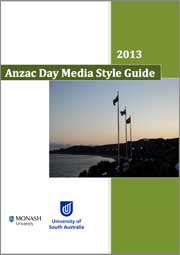17 April 2013
 A new edition of a style guide for journalists reporting on Anzac Day has now been released by University of South Australia (UniSA) researcher and freelance journalist, Sharon Mascall-Dare.
A new edition of a style guide for journalists reporting on Anzac Day has now been released by University of South Australia (UniSA) researcher and freelance journalist, Sharon Mascall-Dare.
The ‘Anzac Day Media Style Guide’ for 2013 has been updated following a positive response when it was first released before Anzac Day last year.
Mascall-Dare says the aim of the guide is to offer journalists advice on accuracy and how to avoid common errors. It has been written for media professionals covering Anzac Day, offering a range of strategies to refresh coverage from year to year.
The 2013 edition includes expanded sections on ranks and military organisation as well as medals. It also includes additional story ideas that draw on Mascall-Dare’s research findings.
“My research has revealed that multiculturalism has always been part of the Anzac story with many of the diggers who served at Gallipoli coming from non-European backgrounds,” Mascall-Dare said. “There were Chinese Anzacs, for example, and there were Anzacs of German descent and Russian descent. There were Indigenous Australians and Maori New Zealanders.
“When I visited the Gallipoli peninsula last year I also documented the different nationalities listed at the Turkish memorial as well as the cemeteries where allied soldiers are buried. So far, I’ve recorded 37 different nationalities that fought at Gallipoli.
“The Anzacs served alongside allied soldiers from a number of countries spanning Africa, the Middle East, Asia, Europe and North America: from India to Newfoundland and French Colonial Africa. I find it fascinating that some Australians have rejected multiculturalism in the context of Anzac Day commemoration even though it was, unquestionably, a multi-national campaign.
“My research has also found that the Anzac story is changing and evolving to acknowledge what individuals remember, and to reflect complexity as opposed to ‘grand narratives’ that give just one version of events. Exploring individual memories and alternative narratives can give journalists new ways to cover Anzac Day and escape cliché.”
The ‘Anzac Day Media Style Guide’ for 2013 has been compiled with input from UniSA, Monash University and the Australian National University.
The Guide is available from http://www.unisa.edu.au/Education-Arts-and-Social-Sciences/Communication-International-Studies-and-Languages/Research/Narratives-of-War/
Media contact: Katrina Phelps, News and Media Team phone (08) 8302 0096 email Katrina.Phelps@unisa.edu.au
For interviews: Sharon Mascall-Dare phone 0414 439 347


